hankyoreh
Links to other country sites 다른 나라 사이트 링크
Minimum wage earners need more than 22 years to save for a house
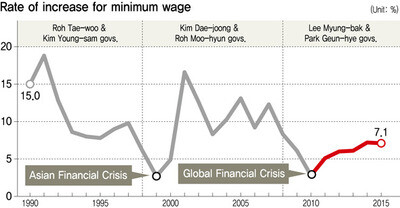
By Kim So-youn, staff reporter
Recent figures released by Real Estate Serve (www.serve.co.kr), a realtor, show that workers making minimum wage would need 22 years and 5 months to save up enough money for a long-term deposit on an apartment in Seoul, even if they saved all of their earnings.
As of the first week of July, the average long-term deposit for an apartment in Seoul was 313.48 million won (US$307,500). In contrast, the 2015 minimum wage, chosen by the Korean Minimum Wage Council on June 26, is 5,580 won per hour (US$5.47). Assuming 209 hours worked per month, that would amount to monthly earnings of 1.17 million (US$1,144), and annual earnings of 13.99 million won (US$13,728). Over the past year, the average long-term deposit for apartments in South Korea went up 17.22 million won, while the minimum wage increased by 877,800 won annually.
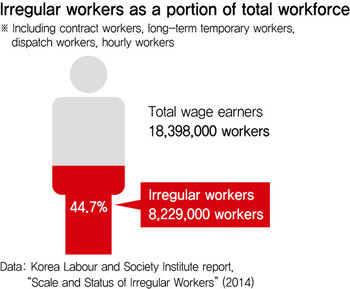
These figures illustrate just how difficult it is to get by in South Korea on minimum wage - and more than 2 million workers earn even less than the minimum wage. Economic experts argue that the only way to increase the stability not only of household income but also of the economy as a whole is to make companies pay a reasonable minimum wage and use the social insurance system to have the government guarantee an “income floor,” or a minimum income level.
According to the 2013 Occupational Labor Force Survey at Establishments, prepared by the Ministry of Employment and Labor, the average hourly wage for regular workers at companies with five or more employees was 15,567 won, while the minimum wage was 4,860 won. The minimum wage was only 31.2% of workers’ average wages. While the minimum wage increased by 2.8% in 2010, 5.1% in 2011, 6% in 2012, and 6.1% in 2013, accounting for inflation, the real rate of increase of the minimum wage has only been -0.2%, 1.1%, 3.7%, and 4.7%.
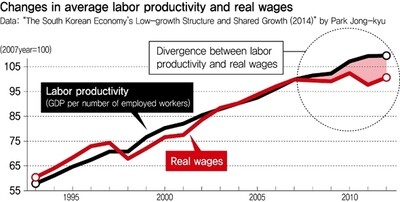
The reason that the minimum wage does not match reality is because it does not adequately reflect the economic growth rate, inflation, and improvement in income distribution. Instead, it is the result of gradual adjustments made by labor and management, while the government passively stands by.
Labor activists contend that the minimum wage ought to be increased to 50% of regular workers’ average wages. While a number of such kinds of bills have been submitted to the National Assembly, the government and the ruling party have prevented their passage.
While the official minimum wage is itself low, an even bigger problem is that companies are not even obeying this. As of March, 2.32 million workers were being paid less than the minimum wage (5,210 won in 2014).
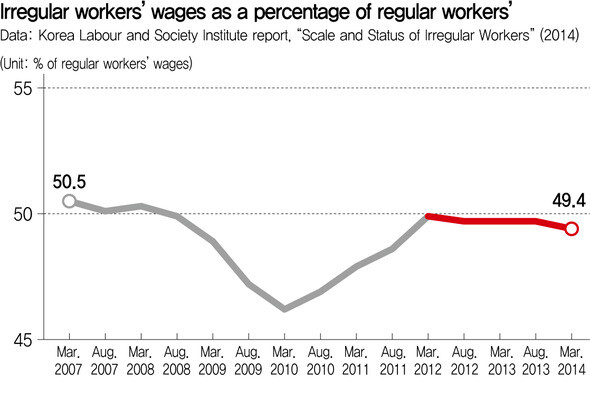
“About one out of eight workers are not even receiving the legal minimum wage. This means that the minimum wage system is not fulfilling its original purpose of resolving low income and the income gap and improving the distribution of wealth. The problem is that the government is not carrying out its responsibility of overseeing labor,” said Kim Yu-seon, senior researcher at the Korea Labour and Society Institute.
"Even in the public sector, which is under the direct management of the government, 140,000 people are earning less than the minimum wage,” Kim added. While commercial and government entities that violate the Minimum Wage Act can be sentenced to up to three years in prison and 20 million won in fines, in reality, it is very rare for them to be prosecuted.
As a result of the low minimum wage and the fact that companies are not even respecting this, both the percentage of low wage earners and the level of wage inequality (a ratio of the highest 10% to the lowest 10%) are both very severe in South Korea.
According to figures provided by the OECD, or the Organization for Economic Cooperation and Development, wage inequality in South Korea was 4.85 as of 2011, the third highest among the 33 member states. The European Union defines low wage earners as those who make less than two thirds of the median income. In South Korea, 25.1% of the population falls into this category. This is 9 percentage points higher than the OECD average of 16.1%, the highest percentage of all member states.
Along with increasing the minimum wage, there is also an urgent need to expand the unemployment allowance and other social insurance programs. In a report titled “Social Wages” published in 2009 by Oh Geon-ho, chair of the operating committee for Welfare State That We Create, social wages cover 7.9% of household operating costs in South Korea, which is one fourth of the 31.9% OECD average. Social wage is a figure that converts social welfare benefits, including unemployment benefits, daycare subsidies, and health insurance payouts, into wages.
Other critics argue that not only the central government but also civil society and local governments need to take active steps to resolve the issue of low wages. The living wage movement that has been spreading recently among local governments can be understood as part of efforts to secure this income floor.
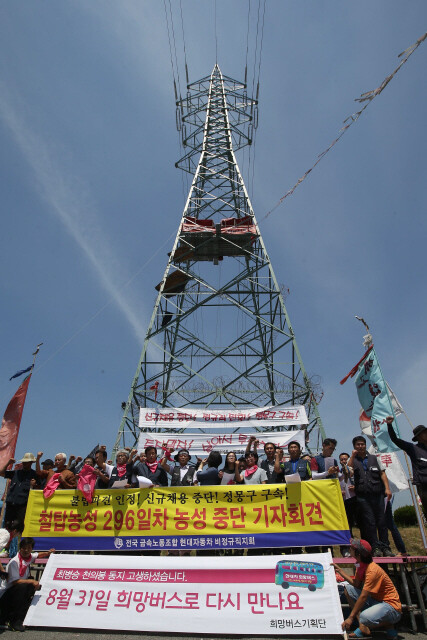
“The living wage movement is a drive to have local governments ensure that at least the residents of their own areas will be paid a wage that they can actually live on. In 2013, the Seongbuk and Nowon Districts of Seoul implemented a living wage system. Recently, the city of Bucheon passed a city ordinance mandating a living wage after deliberations between labor, management, the private sector, and the government, a first in South Korea.
"It is important for an income floor to be created by linking the minimum wage and the social insurance system. This will not only stabilize household income but will also serve as a buffer zone to mitigate the shock caused by a reduction of income during an economic recession,” said Lee Sang-heon, research and policy coordinator for the International Labour Organization.
Please direct questions or comments to [english@hani.co.kr]

Editorial・opinion
![[Column] Season 2 of special prosecutor probe may be coming to Korea soon [Column] Season 2 of special prosecutor probe may be coming to Korea soon](https://flexible.img.hani.co.kr/flexible/normal/500/300/imgdb/original/2024/0426/3317141030699447.jpg) [Column] Season 2 of special prosecutor probe may be coming to Korea soon
[Column] Season 2 of special prosecutor probe may be coming to Korea soon![[Column] Park Geun-hye déjà vu in Yoon Suk-yeol [Column] Park Geun-hye déjà vu in Yoon Suk-yeol](https://flexible.img.hani.co.kr/flexible/normal/500/300/imgdb/original/2024/0424/651713945113788.jpg) [Column] Park Geun-hye déjà vu in Yoon Suk-yeol
[Column] Park Geun-hye déjà vu in Yoon Suk-yeol- [Editorial] New weight of N. Korea’s nuclear threats makes dialogue all the more urgent
- [Guest essay] The real reason Korea’s new right wants to dub Rhee a founding father
- [Column] ‘Choson’: Is it time we start referring to N. Korea in its own terms?
- [Editorial] Japan’s rewriting of history with Korea has gone too far
- [Column] The president’s questionable capacity for dialogue
- [Column] Are chaebol firms just pizza pies for families to divvy up as they please?
- [Column] Has Korea, too, crossed the Rubicon on China?
- [Correspondent’s column] In Japan’s alliance with US, echoes of its past alliances with UK
Most viewed articles
- 1‘We must say no’: Seoul defense chief on Korean, USFK involvement in hypothetical Taiwan crisis
- 2After election rout, Yoon’s left with 3 choices for dealing with the opposition
- 3Why Kim Jong-un is scrapping the term ‘Day of the Sun’ and toning down fanfare for predecessors
- 4AI is catching up with humans at a ‘shocking’ rate
- 5Two factors that’ll decide if Korea’s economy keeps on its upward trend
- 6[Column] Park Geun-hye déjà vu in Yoon Suk-yeol
- 7Division commander ordered troops to enter raging flood waters before Marine died, survivor says
- 8Gangnam murderer says he killed “because women have always ignored me”
- 9South Korea officially an aged society just 17 years after becoming aging society
- 10No good, very bad game for Korea puts it out of Olympics for first time since 1988